典范英语5a Lesson 13自学导案
Lesson 13 I Love Autumn--教案
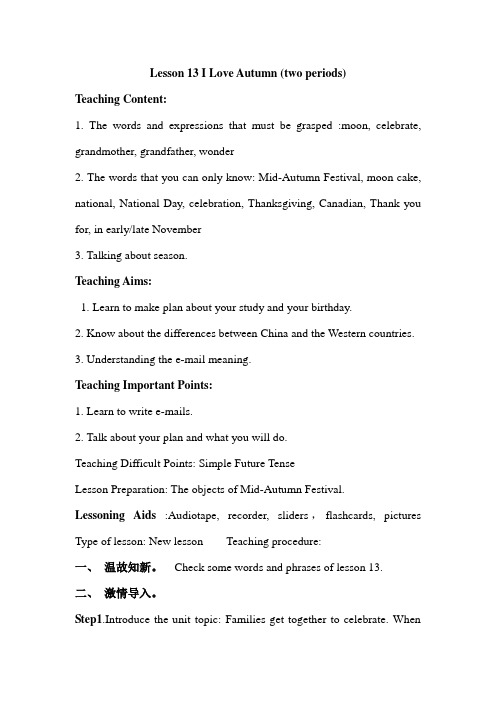
Lesson 13 I Love Autumn (two periods)Teaching Content:1. The words and expressions that must be grasped :moon, celebrate, grandmother, grandfather, wonder2. The words that you can only know: Mid-Autumn Festival, moon cake, national, National Day, celebration, Thanksgiving, Canadian, Thank you for, in early/late November3. Talking about season.Teaching Aims:1. Learn to make plan about your study and your birthday.2. Know about the differences between China and the Western countries.3. Understanding the e-mail meaning.Teaching Important Points:1. Learn to write e-mails.2. Talk about your plan and what you will do.Teaching Difficult Points: Simple Future TenseLesson Preparation: The objects of Mid-Autumn Festival.Lessoning Aids:Audiotape, recorder, sliders,flashcards, pictures Type of lesson: New lesson Teaching procedure:一、温故知新。
典范英语第十三课
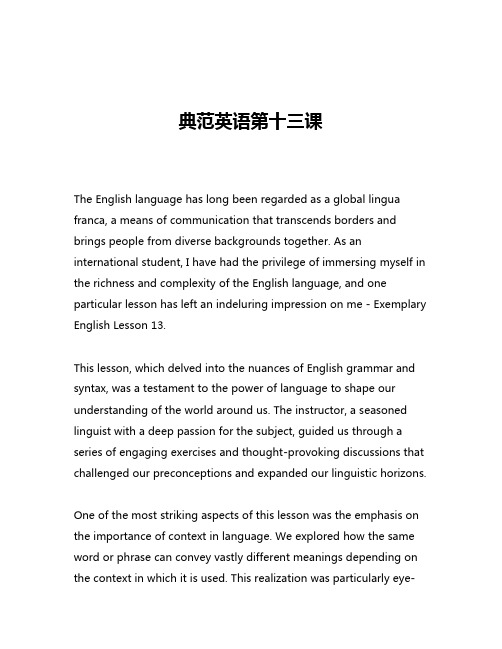
典范英语第十三课The English language has long been regarded as a global lingua franca, a means of communication that transcends borders and brings people from diverse backgrounds together. As an international student, I have had the privilege of immersing myself in the richness and complexity of the English language, and one particular lesson has left an indeluring impression on me - Exemplary English Lesson 13.This lesson, which delved into the nuances of English grammar and syntax, was a testament to the power of language to shape our understanding of the world around us. The instructor, a seasoned linguist with a deep passion for the subject, guided us through a series of engaging exercises and thought-provoking discussions that challenged our preconceptions and expanded our linguistic horizons.One of the most striking aspects of this lesson was the emphasis on the importance of context in language. We explored how the same word or phrase can convey vastly different meanings depending on the context in which it is used. This realization was particularly eye-opening, as it highlighted the need to approach language with a keen sense of awareness and sensitivity.For instance, the word "run" can take on a multitude of meanings - from a simple physical action to a complex financial term. By examining the various contexts in which this word is used, we gained a deeper appreciation for the richness and flexibility of the English language. The instructor encouraged us to think critically about the implications of word choice and to consider how our language can shape the perceptions and responses of our audience.Another key focus of Exemplary English Lesson 13 was the exploration of grammatical structures and their impact on communication. We delved into the intricate web of noun phrases, verb tenses, and sentence structures, learning how these elements work together to convey meaning and nuance. The instructor's ability to break down complex grammatical concepts into accessible and engaging lessons was truly remarkable, and it left us with a newfound respect for the underlying principles that govern the English language.One particularly memorable exercise involved rewriting a passage using different grammatical structures. By experimenting with various sentence constructions, we witnessed firsthand how the same ideas could be expressed in multiple ways, each with its ownunique tone and emphasis. This exercise not only reinforced our understanding of grammar but also highlighted the creative potential of language.Throughout the lesson, the instructor encouraged us to think beyond the confines of traditional grammar rules and to embrace the dynamic and ever-evolving nature of the English language. We discussed the influence of regional dialects, the impact of technological advancements on language, and the role of cultural context in shaping linguistic norms.This holistic approach to language learning was particularly valuable, as it allowed us to see the English language not as a rigid set of rules but as a living, breathing entity that reflects the diversity and complexity of human experience. By understanding the nuances of language, we gained a deeper appreciation for the ways in which we can use words to convey our thoughts, emotions, and perspectives.Perhaps the most profound takeaway from Exemplary English Lesson 13 was the realization that language is not merely a tool for communication but a fundamental aspect of our identity and worldview. The way we use language shapes the way we perceive and interact with the world, and by mastering the intricacies of the English language, we can unlock new avenues of understanding and expression.As I reflect on this transformative lesson, I am filled with a renewed sense of purpose and enthusiasm for the study of English. The skills and insights I have gained will not only enhance my academic and professional pursuits but also enrich my personal growth and understanding of the human experience. I am grateful for the opportunity to have been a part of this exemplary lesson, and I am confident that the knowledge and perspectives I have gained will continue to serve me well in the years to come.。
人教精通版英语5上Lesson13
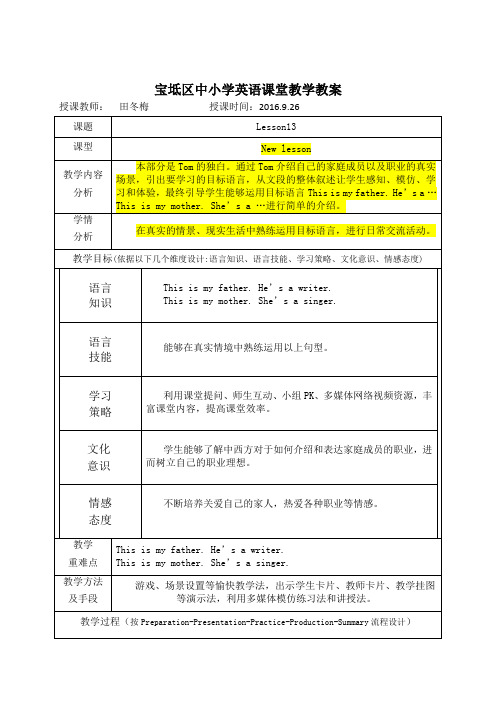
师生活动
设计意图
时间
Step1:Preparation
Step2:
ntation
Step3:Practice
Step4:Production
Step5:Summary
播放歌曲My family的磁带。
学生听磁带演唱。
教师让学生自由结合成六人学习小组进行全班交流。交流的方式可以是问答,也可以采用叙述的形式来完成。教师要引导学生根据提出的问题多少及正确与否给各组一个客观公正的评价。
宝坻区中小学英语课堂教学教案
授课教师:田冬梅授课时间:2016.9.26
课题
Lesson13
课型
New lesson
教学内容
分析
本部分是Tom的独白。通过Tom介绍自己的家庭成员以及职业的真实场景,引出要学习的目标语言,从文段的整体叙述让学生感知、模仿、学习和体验,最终引导学生能够运用目标语言This is my father.He’s a…This is my mother.She’s a…进行简单的介绍。
This is my mother. She’s a singer.
教学反思
学情
分析
在真实的情景、现实生活中熟练运用目标语言,进行日常交流活动。
教学目标(依据以下几个维度设计:语言知识、语言技能、学习策略、文化意识、情感态度)
语言
知识
This is my father. He’s awriter.
This is my mother. She’s asinger.
语言
技能
能够在真实情境中熟练运用以上句型。
This is my mother. She’s a singer.
教学方法及手段
典范英语5a lesson5概括

典范英语5a lesson5概括摘要:一、课程背景1.典范英语5a 课程2.课程目标3.课程难度二、第五课概述1.课文主题2.主要角色3.故事情节三、课文学习重点1.生词和短语2.语法结构3.口语表达四、文化背景知识1.英国节日2.英国风俗习惯3.跨文化交流五、课程学习建议1.课前预习2.课堂互动3.课后复习正文:典范英语5a 课程是我国英语学习者学习英语的一门重要课程,适用于具备一定英语基础的学习者。
课程目标是帮助学习者提高英语听、说、读、写四项基本技能,并通过学习英语文章,了解英国文化和风俗习惯。
在第五课中,我们学习了一篇关于英国节日的文章。
文章以一位英国小女孩的视角,讲述了她如何期待和度过圣诞节的过程。
故事中涉及了圣诞节的诸多传统习俗,如装饰圣诞树、给亲友送礼物、唱圣诞歌等。
通过学习这篇文章,我们可以了解到英国的圣诞节是如何庆祝的,以及其中所蕴含的文化内涵。
在第五课的学习中,我们需要掌握一些生词和短语,如“decorate”(装饰)、“gift”(礼物)等。
此外,还要学习一些语法结构,如一般现在时和一般过去时的运用。
在口语表达方面,我们可以学习如何描述一个节日的庆祝过程和氛围。
学习英语不仅仅是学习语言本身,还包括了解英语国家的文化背景。
在这篇文章中,我们可以了解到英国的圣诞节是如何庆祝的,以及英国人在节日期间的一些风俗习惯。
了解这些文化背景对于提高跨文化交流能力具有重要意义。
为了更好地学习第五课,我们建议在课前进行预习,提前阅读课文并查阅生词。
在课堂上,要积极参与讨论和互动,向老师请教不懂的问题。
课后,要进行复习,巩固所学知识,并尝试运用到实际交流中。
《典范英语》(5a-L13)教学参考
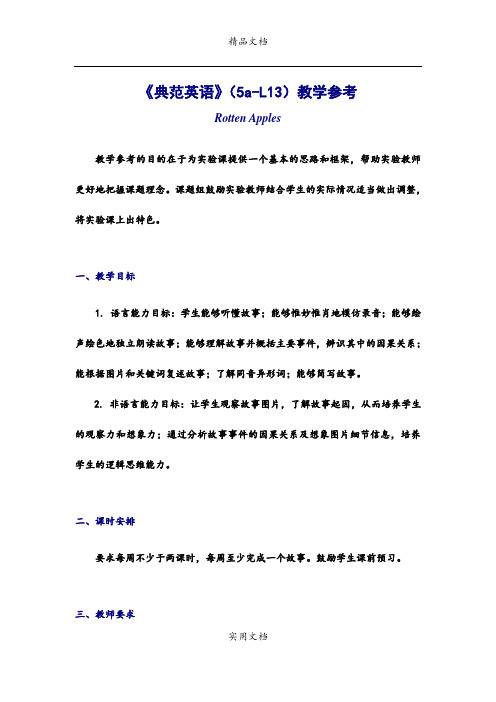
《典范英语》(5a-L13)教学参考Rotten Apples教学参考的目的在于为实验课提供一个基本的思路和框架,帮助实验教师更好地把握课题理念。
课题组鼓励实验教师结合学生的实际情况适当做出调整,将实验课上出特色。
一、教学目标1. 语言能力目标:学生能够听懂故事;能够惟妙惟肖地模仿录音;能够绘声绘色地独立朗读故事;能够理解故事并概括主要事件,辨识其中的因果关系;能根据图片和关键词复述故事;了解同音异形词;能够简写故事。
2. 非语言能力目标:让学生观察故事图片,了解故事起因,从而培养学生的观察力和想象力;通过分析故事事件的因果关系及想象图片细节信息,培养学生的逻辑思维能力。
二、课时安排要求每周不少于两课时,每周至少完成一个故事。
鼓励学生课前预习。
三、教师要求1. 教师课前须熟读故事,了解故事内容。
2. 对于较难的单词,教师可板书,并配合动作和表情帮助学生理解。
3. 全英文授课。
四、教学用具多媒体设备、CD机、课件(课题组提供)、故事图片及关键词卡片(见复述环节)。
五、课堂教学基本步骤1. 导入(Lead-in):讨论醉酒话题,引入故事情境通过播放drunk animals的视频,引出讨论话题,为看图讲故事做铺垫。
教师播放视频(见课件),并与学生互动,并自然过渡到讲故事环节:What happened to the animals?How did the animals get drunk?What is a drunk horse like? Can you act as a drunk horse? There was a drunk horse in the story. How did the horse get drunk? Let’s learna new story Rotten Apples.(板书故事标题)2. 看图讲故事(Storytelling):理解故事情节,了解故事起因教师利用课件播放故事图片1-4,并用丰富的表情、生动的英文和适当的肢体语言给学生绘声绘色地讲故事,引导学生观察图片,了解故事起因。
五年级英语上册 Module 5 Unit 13(6)教案 广州版
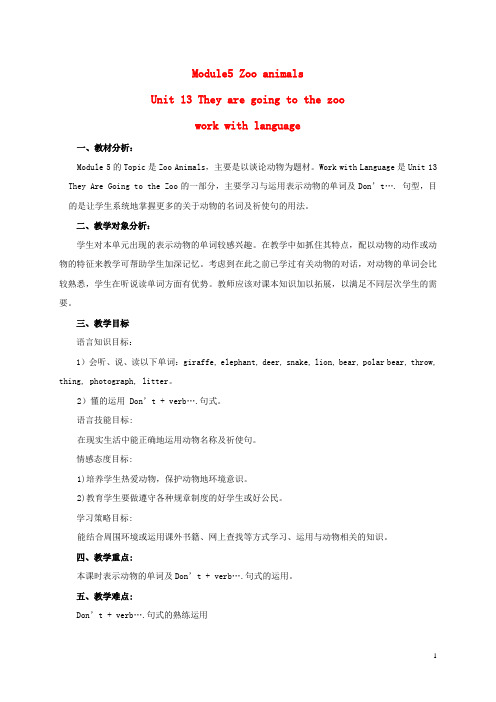
Module5 Zoo animalsUnit 13 They are going to the zoowork with language一、教材分析:Module 5的Topic是Zoo Animals,主要是以谈论动物为题材。
Work with Language是Unit 13 They Are Going to the Zoo的一部分,主要学习与运用表示动物的单词及Don’t…. 句型,目的是让学生系统地掌握更多的关于动物的名词及祈使句的用法。
二、教学对象分析:学生对本单元出现的表示动物的单词较感兴趣。
在教学中如抓住其特点,配以动物的动作或动物的特征来教学可帮助学生加深记忆。
考虑到在此之前已学过有关动物的对话,对动物的单词会比较熟悉,学生在听说读单词方面有优势。
教师应该对课本知识加以拓展,以满足不同层次学生的需要。
三、教学目标语言知识目标:1)会听、说、读以下单词:giraffe, elephant, deer, snake, lion, bear, polar bear, throw, thing, photograph, litter。
2)懂的运用Don’t + verb….句式。
语言技能目标:在现实生活中能正确地运用动物名称及祈使句。
情感态度目标:1)培养学生热爱动物,保护动物地环境意识。
2)教育学生要做遵守各种规章制度的好学生或好公民。
学习策略目标:能结合周围环境或运用课外书籍、网上查找等方式学习、运用与动物相关的知识。
四、教学重点:本课时表示动物的单词及Don’t + verb….句式的运用。
五、教学难点:Don’t + verb….句式的熟练运用六、教学过程一)Warm up1.Sing a song :跟着录音唱。
T: Answer my questions: What does a kangaroo do? How manyanimals in a zoo do you know? 小组交流自己准备的动物图片及所对应的单词。
牛津5A全套教案

牛津小学英语5A教案——Unit 1Unit 1 第一教时教学目标:1,能正确理解、掌握对话内容,并能朗读,初步表演对话。
2,能正确地听、说、读、写day,all.any,a reading room.sure.floor.3,能正确的听、说、读词汇first,a term,back.each other.glad.a building,a sports hall.table tennis,second.4,正确的听、说、读、写句型Is there a…?Yes,there is./No,there isn't. Are there any…?Yes,there are?/No,there arent't.How many… are there?There are…5,能正确地运用对话中的日常交际用语和三会句型It is the first day of… They are happy to each othere.Glad to see you.I'm not sure.It's /They're on the …floor.教学重点:能正确理解、掌握对话内容。
并能朗读、初步表演对话。
教学难点:1,能比较流畅的朗读对话,并能在掌握对话内容的基础上进一步表演对话。
2,能正确的听、说、读、写There be…句型的一般疑问句形式及其肯定和否定回答。
课前准备:课件、挂图、录音机。
教学过程:一、: Revision:1,T:Good morning,boys and girls.S:T:Nice to see you . S:T:How are you?T:My name is …What's your name?2,practise in pairs:老师小结OK.I see. You're happy to see each other.(板书。
五年级上册英语教案Module5 Unit13|广州版
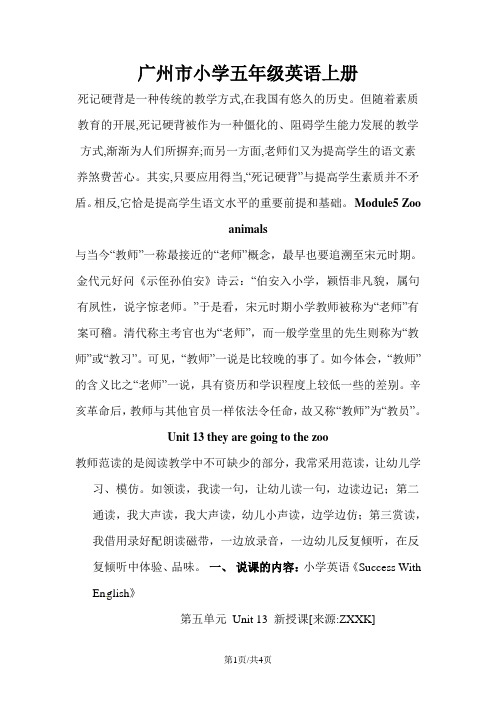
广州市小学五年级英语上册死记硬背是一种传统的教学方式,在我国有悠久的历史。
但随着素质教育的开展,死记硬背被作为一种僵化的、阻碍学生能力发展的教学方式,渐渐为人们所摒弃;而另一方面,老师们又为提高学生的语文素养煞费苦心。
其实,只要应用得当,“死记硬背”与提高学生素质并不矛盾。
相反,它恰是提高学生语文水平的重要前提和基础。
Module5 Zooanimals与当今“教师”一称最接近的“老师”概念,最早也要追溯至宋元时期。
金代元好问《示侄孙伯安》诗云:“伯安入小学,颖悟非凡貌,属句有夙性,说字惊老师。
”于是看,宋元时期小学教师被称为“老师”有案可稽。
清代称主考官也为“老师”,而一般学堂里的先生则称为“教师”或“教习”。
可见,“教师”一说是比较晚的事了。
如今体会,“教师”的含义比之“老师”一说,具有资历和学识程度上较低一些的差别。
辛亥革命后,教师与其他官员一样依法令任命,故又称“教师”为“教员”。
Unit 13 they are going to the zoo教师范读的是阅读教学中不可缺少的部分,我常采用范读,让幼儿学习、模仿。
如领读,我读一句,让幼儿读一句,边读边记;第二通读,我大声读,我大声读,幼儿小声读,边学边仿;第三赏读,我借用录好配朗读磁带,一边放录音,一边幼儿反复倾听,在反复倾听中体验、品味。
一、说课的内容:小学英语《Success With English》第五单元Unit 13 新授课[来源:ZXXK]二、说教材:这个单元的主题是动物园的动物,主要是让学生系统地掌握更多的关于动物的名词了解动物园的规则及祈使句的用法。
在二年级和三年级的教材中也出现了关于动物的topic,二年级学习的是动物园的动物;三年级学习的主要是家里面饲养的宠物;而在本册书第二单元表示能力的教学中也涉及了动物,因而学生在学习这一单元前已经有了一定的基础。
[来源:ZXXK][来源:][来源:学。
科。
网Z。
X。
X。
K][来源:ZXXK]三、说学生:这个单元的话题贴近生活,学生容易理解并且很感兴趣。
转:典范英语(原:牛津阅读树ORT)详细学习方案(含1-5级、6-9级、拼读)

转:典范英语(原:牛津阅读树ORT)详细学习方案(含1-5级、6-9级、拼读)2岁孩子从“零”开始学英语,典范英语1-5级婴幼儿,从来没有学过英语,一点基础都没有,26个字母,也从来没有学过。
如果想学英语,从学什么开始呢?我们特别推荐《典范英语》1-5级。
《典范英语》是一套从英国牛津大学出版社原版引进的英语学习材料,原名《牛津阅读树》(Oxford Reading Tree,简称ORT),使用范围遍及世界各地,在英国有80%的学校用它教学生学习母语,全球有133个国家用它教学生学习外语。
《典范英语》出版时,从ORT中精选出几百个最适合我国中小学学生学习的故事和文学读本,配有大量原版绘制的精美插图和纯正的录音材料,完全适合我国中小学学生学习英语使用,它是一套融故事性、人文性、趣味性、专业性、系统性于一体的英语阅读教材。
兴趣,是小孩子学习英语,首先要考虑的。
而典范英语1-5级别最大的亮点就在于此。
下面,来介绍一下这套书的主要特色:趣味十足:典范英语1-5级,如果只说一个特点,那就是趣味十足。
小孩子学英语,为什么不容易坚持,为什么会有厌学情绪,主要原因之一就是教材趣味性不足。
那么,这也就告诉家长或者老师,选择的学习素材一定要十分有趣,只有这样,孩子才能喜欢学,喜欢了,才能坚持学下去。
凡是孩子刚开始学英语的家长咨询我,开始选用什么书,我就告诉家长选择有趣的素材,典范英语,就是有趣的这种学习素材;配图好玩:一条狗狗Floppy,一直陪伴着典范英语彩图书。
当孩子自己随便翻书的时候,他(她)基本是不认识书上面这些单词的,但是,孩子能看懂图。
通过看这些彩图,孩子看懂后,时常会呵呵笑起来。
这就是配图好玩有趣的魔力。
小孩子学习,就要选择这样的书。
看看图,就会笑,这不正说明典范英语适合孩子嘛?好的配图有助于孩子理解故事;价格昂贵:在目前国内有的原版英语素材中,典范英语是价格比较昂贵的一类。
正因为如此,2009年,我们得知典范英语的时候,并没有向原典英语自学者推荐。
典范英语5a13课文稿
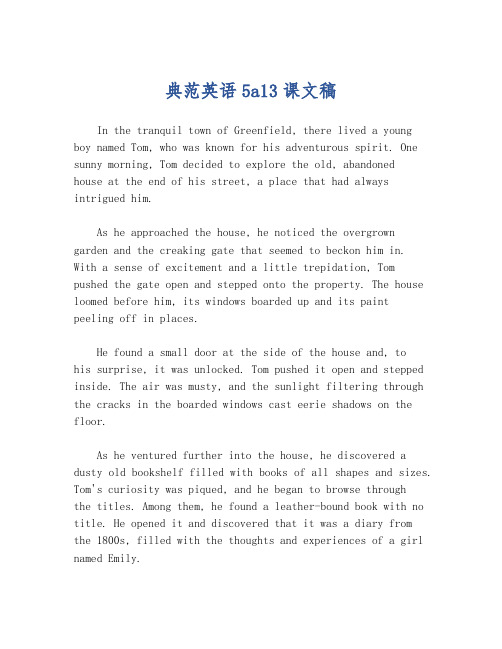
典范英语5a13课文稿In the tranquil town of Greenfield, there lived a young boy named Tom, who was known for his adventurous spirit. One sunny morning, Tom decided to explore the old, abandonedhouse at the end of his street, a place that had always intrigued him.As he approached the house, he noticed the overgrown garden and the creaking gate that seemed to beckon him in.With a sense of excitement and a little trepidation, Tom pushed the gate open and stepped onto the property. The house loomed before him, its windows boarded up and its paintpeeling off in places.He found a small door at the side of the house and, tohis surprise, it was unlocked. Tom pushed it open and stepped inside. The air was musty, and the sunlight filtering through the cracks in the boarded windows cast eerie shadows on the floor.As he ventured further into the house, he discovered a dusty old bookshelf filled with books of all shapes and sizes. Tom's curiosity was piqued, and he began to browse throughthe titles. Among them, he found a leather-bound book with no title. He opened it and discovered that it was a diary fromthe 1800s, filled with the thoughts and experiences of a girl named Emily.The diary entries painted a vivid picture of life in the 19th century, and Tom was captivated by Emily's stories of friendship, family, and the small joys of life. He read about her adventures in the countryside, her struggles with school, and her dreams for the future.As the afternoon sun began to set, Tom realized that he had spent hours reading Emily's diary. He decided to take the book home with him, hoping to learn more about the girl who had lived in the house so many years ago.That night, as Tom lay in bed, he couldn't help but feel a connection to Emily. Her diary had opened a window into the past, and he felt as though he had made a friend across time. He promised himself that he would return to the old house and uncover more of its secrets.The next day, Tom shared his discovery with his friends, and they all agreed to explore the house together. They found more artifacts and clues that revealed the history of the house and its former inhabitants. The old house, once a source of fear and mystery, had become a treasure trove of stories and a testament to the enduring power of human connection.In the end, Tom's adventure not only brought him a new friend in Emily but also taught him the importance of preserving history and appreciating the stories that shape our lives. The old house, once a symbol of the unknown, had become a bridge between the past and the present, and Tomfelt honored to be a part of its rediscovery.。
高中英语必修五 Unit13-经典教学教辅文档
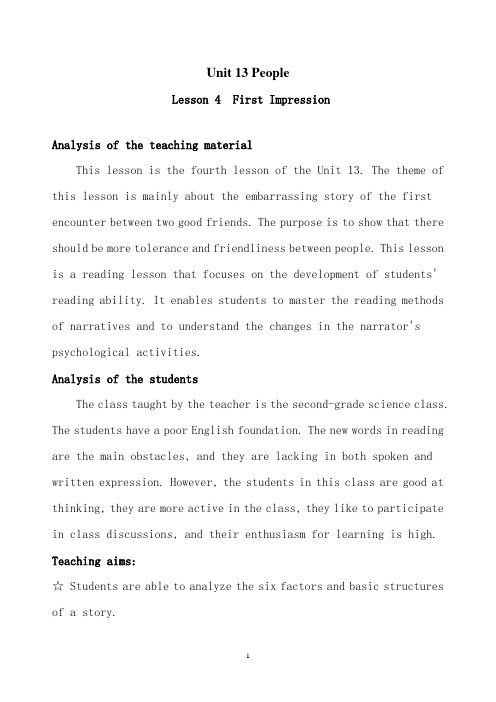
Unit 13 PeopleLesson 4 First ImpressionAnalysis of the teaching materialThis lesson is the fourth lesson of the Unit 13. The theme of this lesson is mainly about the embarrassing story of the first encounter between two good friends. The purpose is to show that there should be more tolerance and friendliness between people. This lesson is a reading lesson that focuses on the development of students' reading ability. It enables students to master the reading methods of narratives and to understand the changes in the narrator's psychological activities.Analysis of the studentsThe class taught by the teacher is the second-grade science class. The students have a poor English foundation. The new words in reading are the main obstacles, and they are lacking in both spoken and written expression. However, the students in this class are good at thinking, they are more active in the class, they like to participate in class discussions, and their enthusiasm for learning is high. Teaching aims:☆ Students are able to analyze the six factors and basic structures of a story.☆Students are able to finish the practices with the reading strategies.☆ Students are able to use different expressions to describe the feelings in the first impression.Teaching important and difficult points:☆ To find out the six factors and basic structure of the story.☆ To finish the summary of the text.Teaching aids:☆multi-media and blackboardTeaching methods:☆Task-based Language Teaching Method☆Communitive Teaching MethodTeaching procedures:Step Ⅰ Lead-inThe teacher shows a movie clip of Pride and Prejudice and then asks the following questions:Q1: What’s Elizabeth’s first impression on Darcy?Q2: Do you think that the first impression is always right?The students can discuss with their partners and then the teacher should invite some students to show their answers and give some comments.设计意图:经过观看电影片段并回答成绩,导入本课话题“第一印象”,并激发先生对本课的学习兴味。
典范英语5a读书笔记
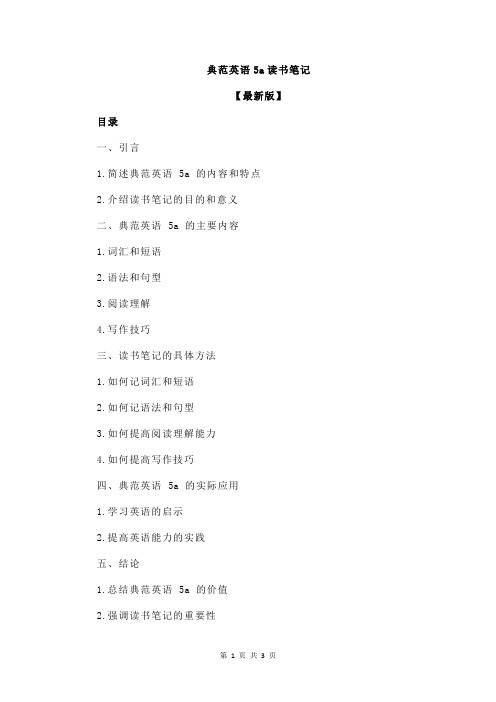
典范英语5a读书笔记【最新版】目录一、引言1.简述典范英语 5a 的内容和特点2.介绍读书笔记的目的和意义二、典范英语 5a 的主要内容1.词汇和短语2.语法和句型3.阅读理解4.写作技巧三、读书笔记的具体方法1.如何记词汇和短语2.如何记语法和句型3.如何提高阅读理解能力4.如何提高写作技巧四、典范英语 5a 的实际应用1.学习英语的启示2.提高英语能力的实践五、结论1.总结典范英语 5a 的价值2.强调读书笔记的重要性正文一、引言典范英语 5a 是一本针对英语学习者的教材,它以丰富的内容和独特的教学方法,成为了许多学习者的首选。
这本书涵盖了英语的各个方面,包括词汇、语法、阅读理解和写作技巧等。
对于学习者来说,如何更好地利用这本书,提高自己的英语能力,成为了一个重要的问题。
这时候,读书笔记就发挥了它的作用。
二、典范英语 5a 的主要内容1.词汇和短语:典范英语 5a 包含了大量的词汇和短语,这些词汇和短语是英语学习的基础。
在读书笔记中,我们可以将这些词汇和短语记录下来,并加以分类和整理,以便于记忆和应用。
2.语法和句型:典范英语 5a 中的语法和句型是英语学习的重点和难点。
在读书笔记中,我们可以将这些语法和句型进行归纳和总结,以便于理解和掌握。
3.阅读理解:典范英语 5a 中的阅读理解部分是提高英语阅读能力的重要部分。
在读书笔记中,我们可以记录下阅读理解的方法和技巧,以便于应用到实际的阅读中。
4.写作技巧:典范英语 5a 中的写作技巧部分是提高英语写作能力的关键部分。
在读书笔记中,我们可以记录下写作技巧和方法,并结合实际的写作练习,提高自己的写作能力。
三、读书笔记的具体方法1.如何记词汇和短语:在读书过程中,我们可以将遇到的生词和短语记录下来,并注明其意思和用法。
同时,我们还可以将这些词汇和短语进行分类,比如按照主题或者词性等。
2.如何记语法和句型:在读书过程中,我们可以将遇到的语法和句型记录下来,并结合实例进行解释。
- 1、下载文档前请自行甄别文档内容的完整性,平台不提供额外的编辑、内容补充、找答案等附加服务。
- 2、"仅部分预览"的文档,不可在线预览部分如存在完整性等问题,可反馈申请退款(可完整预览的文档不适用该条件!)。
- 3、如文档侵犯您的权益,请联系客服反馈,我们会尽快为您处理(人工客服工作时间:9:00-18:30)。
Good English 5a
Lesson 2 Rotten Apples 自学导案
Class:__________ Name:___________
一.听读练习
1.自读课文一遍,观察图,大致了解故事内容。
读完后,请圈出
新单词(不会读及不理解的单词),并运用已学过的自然拼读,拼读出所有新单词。
新单词及词组为:rotten empty pull the rein你认为的新单词有:________________。
自我评价:
2.第一遍听录音,听读整篇故事,检查自己刚刚拼读过的新单词
发音是否正确。
跟读新单词并进行练习。
解决的新单词有:
__________________________________。
自我评价:
3.第二遍听录音,结合图片和句子,理解故事,根据故事情节划
分故事,并在书上标记。
4.第三遍听录音,逐句跟读全文,惟妙惟肖地模仿录音,请注意
语音语调及语速。
自我评价:
5.有感情地独立朗读一遍课文。
自我评价:
二.理解练习。
根据课文内容回答问题:
1.Why did Biff say “what a greedy horse!”?
_______________________________________
2.What did Harry Smith say at the end of the story?
_______________________________________
3.Why did the horse get drunk and go to sleep?
_______________________________________
4.Why did Harry Smith sell everything?
_______________________________________
5.Why did Harry Smith give the children a present?
_______________________________________
三.家庭作业
1.熟读课文。
有能力的同学请分角色与班里同学组合进行朗读。
2.完成本课练习册。
